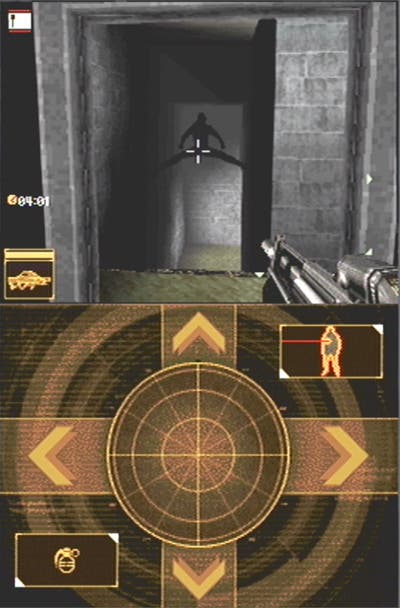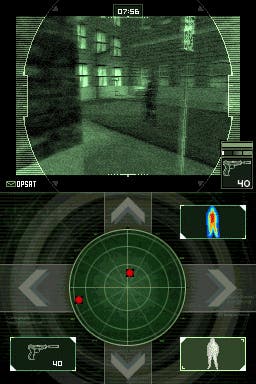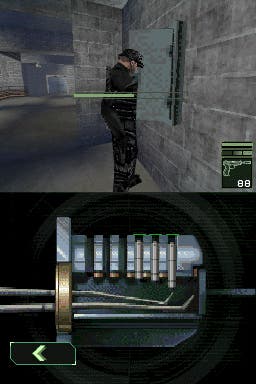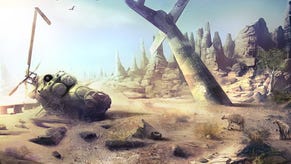Tom Clancy's Splinter Cell: Chaos Theory
Stealth via stylus - our verdict.
Say hello, again, to top counter-terrorist operative and night vision goggles fan Sam Fisher - now starring in his first 3D adventure on a handheld. Now, it's no easy task to capture all the complexities of Splinter Cell's gameplay and control systems on a portable machine, as previous GBA titles have proved. However, we had higher hopes for Chaos Theory DS - after all, there are two screens to play with and one of them's touchable, for starters.
But sadly, although it's clear that Ubisoft has done its best to make the most of the handheld's capabilities, it's also clear that they've fundamentally booned it. While Chaos Theory DS is an ambitious game that, had they achieved what they set out to do, could have raised the bar with regard to what we can expect from our handheld ports, it's massively flawed in key areas - and as a result, it's just not much fun to play.
It all starts to go wrong before you've even embarked on your first mission, when you notice that the menu screens seem a little slow to load and respond - the first sign that perhaps the DS isn't up to the task that's being thrown at it.
Once you're in the game, your suspicions are quickly confirmed as you realise things don't just move slowly when you're navigating menu screens, but also corridors, caves, ventilation shafts and indeed anywhere that Mr Fisher happens to find himself. Put bluntly, the frame rate is appalling.
You've been framed

Visual issues are never a good thing, but it's a particular problem for this game - one of the things that elevates the console and PC versions of Splinter Cell above so many other generic stealth shooters on the shelves is that it's so impressive visually. But the DS version suffers terribly from not only dropped frames but blocky graphics, clumsy animations and the fact that many of the environments are hopelessly dark and dingy.
Of course, we weren't expecting a handheld port to be up to the same graphical standards as its bigger brothers. But we had hoped for some semblance of smoothness in the graphics, and the ability to see what's going on most of the time. Chaos Theory DS fails on both counts, and rather badly.
It's all made worse by the fact that the control system is awkward, unintuitive and generally over-complicated. You control Sam using the D-pad and the camera using the touch screen, which feels like a rather pointless concept and generally proves to be a bit of a pain.
This is especially true when you're trying to aim your crosshair at an enemy, which is done once again on the touch screen. This is fine if you're safely crouched behind a crate and looking to pick off a guard with a single sniper shot to the brains - but if you've just been spotted and are frantically trying to gun him down before he does the same to you, it's a nightmare.
The D-pad/touch screen system also makes simply running away from said guard to find a crafty hiding place very tricky, since there's just no quick way of turning Sam to face the right way and then moving the camera into the correct position. So, nine times out of ten, if a guard is alerted to your presence you are left flailing wildly for a few seconds only to find yourself staring at the MISSION FAILED screen before you've even had a chance to start running in the direction you want to go.
Needless to say, the whole point is not to alert anyone to your presence in the first place and Chaos Theory DS features gameplay elements which reinforce this point - so if a guard spots his mate's dead body he'll realise something's up, and if you trigger more than three alarms it's game over. These are key features of earlier Splinter Cell games that were oddly missing from the console versions of Chaos Theory, and it's good to have them back as they do add an extra challenge.
And a sense of challenge is something that's much needed, since there's an awful lot of repetition in the gameplay as you work your way through each mission. There's just nothing much to do other than visit a series of similar-looking rooms, deal with guards by either creeping up on them or shooting them from afar, climb the odd ladder or hang off the odd pipe and hack computers (not the trickiest of tasks, this - go up to computer. Press Y. Wait five seconds as green bar fills up. The end).
Lock and load

But wait - we're forgetting the "mini-games", as they're described in the manual, of which there are precisely two. The first involves picking locks using the stylus and the touch screen, which requires absolutely no skill and is simply a matter of touching each pin till something goes click. The second requires you to enter a four button code, again using the stylus, on a numeric keypad. They're about as challenging as opening your front door or getting money out of a cashpoint, and just as interesting.
Even Sam's famous night vision goggles aren't much use in this game - putting them on simply makes everything look green and black and fuzzy rather than grey and black and fuzzy. And thermal vision isn't much cop either, since all it allows you to see are some brightly coloured blobs against a wash of blue, meaning you're highly likely to lose your bearings and walk into a wall. About as effective as that pair of X-Ray specs you bought from the Pound Shop.
A compelling narrative was never really Splinter Cell's strong point, but the plot in Chaos Theory DS is particularly tiresome since it unfolds via a series of complicated text messages scrolling slowly across the screen. It's very hard to keep track of what you're supposed to be doing or care about why you're supposed to be doing it when you're sitting through yet another paragraph about "computer algorithms", "standalone generators" and "second-rate communist revolutionaries." Imagine the script of an entire episode of 24 tapped out on a mobile phone by your Mum, while she firmly maintains that predictive text "just doesn't make any sense," and you'll get the picture.
Co-op on the edge

There are two multiplayer modes, but both suffer from the same old problems of fiddly controls and sluggish graphics. Two player co-op sees one of you taking on the role of a computer hacker type while the other deals with the guards - not a bad system, but it's annoying that your partner doesn't show up on the radar screen so you can't keep track of what he's up to.
You'll need more than two players to make Versus Mode anything more enjoyable than a simple game of hide and seek, and since you need a cartridge for each player you'll need to buy more copies of the game than really deserve to be sold - in short, it's just not worth it.
So does Chaos Theory DS have any redeeming features? Well, if you're a die hard Splinter Cell fan, you might learn to live with the shonky control system and poor quality graphics. It's not as if the game is completely unplayable, after all. However, it's not varied or involving enough for our tastes, and the ratio of frustration to enjoyment is far too high. We're still optimistic that one day we'll see a DS port of a third person adventure that offers the same level of entertainment as the original - but Chaos Theory isn't it.









